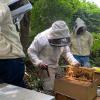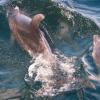Comparative Spatial Ecology Of Fished Spiny Lobsters Panulirus Argus And An Unfished Congener P. Guttatus In An Isolated Marine Reserve At Glover's Reef Atoll, Belize
Palinurid lobsters are being exploited with increasing intensity in coral reef ecosystems, but marine protected areas may play a key role in preventing overfishing and local extinctions. In order to define the spatial requirements for protection, we compared the spatial and temporal patterns in distribution, density, biomass, size structure, and reproductive seasonality of Caribbean spiny lobsters Panulirus argus and the congeneric spotted lobsters P. guttatus on coral patch reef, forereef, and deep reef habitat at Glover's Reef, Belize. The relative impact of fishing on P. argus was also examined in an isolated marine reserve and adjacent fished habitats, in comparison with the relatively unfished distribution of P. guttatus. Over a 5-year period, both species co-occurred in all major reef habitats, but aspects of their population dynamics differed markedly due to both habitat and fishing effects. All size classes of spiny lobsters P. argus occupied shallow patch reefs, but large adults were predominant on the deep wall reef. Panulirus guttatus also occupied patch reefs in the lagoon, but spur-and-groove forereef appeared to be the primary habitat of this species. Density and exploitable (adult) biomass of P. argus increased significantly over time in the protected patch reef habitat of the lagoon but remained stable on deep reef habitat. The biomass of spotted lobsters P. guttatus in all habitats was at least an order of magnitude less than that of exploitable P. argus. Reproductive activity by both species was evident most of the year in all habitats, but breeding P. argus females were concentrated on the deep reef. Commercial fisheries for spotted lobsters P. guttatus are currently being considered for development, but data from this and other studies suggest that such a fishery may be relatively unproductive and may lead to rapid localized extinctions. Spiny lobsters P. argus used a variety of coral reef habitats, but spotted lobsters P. guttatus were habitat specialists restricted to shallow reef habitat. The protection needs of both species are similar in one aspect: large protected areas. However, P. argus required large areas with heterogeneous habitats including coral reefs and seagrass beds, whereas P. guttatus required large areas of coral reef habitat.
Area of Interest: Belize
Year: 2003




